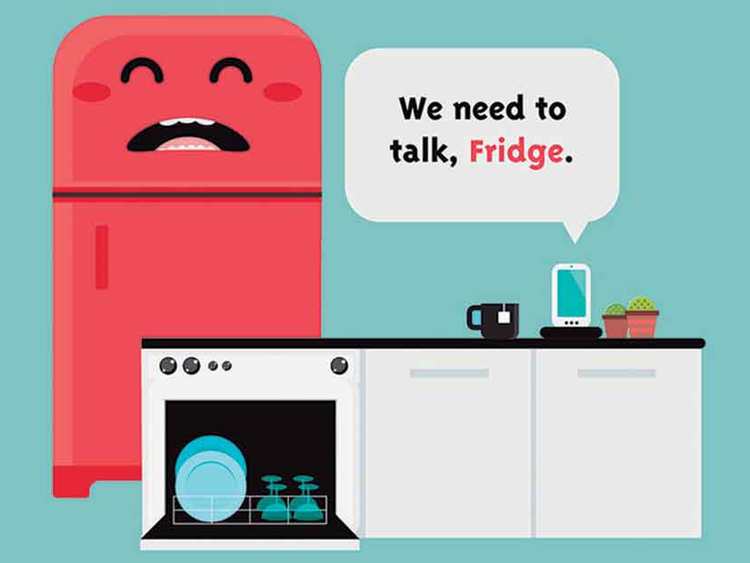Progress in one area of technology often nudges other categories forward.
Even the home appliances market, thus far relatively resistant to change, has been impacted by buzzwords such as the internet of things (IoT), cloud computing and artificial intelligence (AI), as dumb appliances gradually make way for their smarter successors.
Business intelligence firm Transparency Market Research, in its 2016-2024 forecast, says the connected appliance, driven by the rising adoption of mobile devices, high-speed internet and an increased focus on energy efficiency, is here to stay. “Though the prices of these products are currently higher than traditional non-smart appliances, the market will soon feature economic products as more device manufacturers challenge themselves to include connectivity features in their appliances,” the report says.
Research firm MarketsandMarkets predicts the smart appliances market will reach $37.2 billion (Dh136.63 billion) by 2020, an impressive jump from $7.7 billion in 2014.
And by 2020, an estimated 31.3 per cent of households will have some kind of smart connected appliance — up from a mere 0.2 per cent in 2014, research firm IHS Technology forecasts. “This smart appliance market will soon turn out to be a volume game rather than a value game with many technology options available to consumers. The declining cost of connectivity modules would be another key growth driver.”
Below we look at five ways you are going to encounter home appliances.
The fridge that shops
OK, this has been a long time coming, but it really is here. The Samsung Family Hub fridge comes with internal cameras that keep track of groceries and sends status updates to your smartphone. In certain regions, you can order resupplies using the integrated Groceries by MasterCard app — MasterCard claims this is the first shopping app built into a refrigerator, connecting consumers to grocers “in the most convenient and efficient setting – their kitchen”.
LG too is in the fray with the Smart InstaView refrigerator, which integrates Amazon’s Alexa voice assistant, letting you order groceries simply by talking to the fridge.
In the years ahead, expect fridges, washing machines and other home appliances that are smart enough to sense when stocks are running low and then automatically order supplies.
Robots to the rescue
Fortunately, they won’t be gunning after humanity like the machines from the Terminator movies. As Google Home and Amazon Echo have shown, your home will soon be overrun by an army of robots, keeping floors clean, doing the dishes, controlling other appliances, and even entertaining the family with song and dance.
LG announced plans to introduce a bunch of home robots at this year’s Consumer Electronics Show in Las Vegas and demoed the Hub Robot at CES 2017 — the bot has an animated face, understands voice commands and can act as a hub for connected appliances around your home. Presumably, this includes the LG Robo Mower for that lawn outside.
Also on display at this year’s CES was Mayfield Robotics’ Kuri — this cute bot can lord over smart home products, recognise family members and respond to their commands. And it also has mood swings, conveyed through changing colours.
Remote control
Many appliances will soon be accessible from anywhere in a world, allowing you to plan ahead.
For instance, if you are going to be in office longer than expected, you can pull out a smartphone and tell your flock of home appliances that you will be late. Smart ovens and cookers such as the Belkin Crock-Pot already allow you to remotely change the cooking time and temperature.
Similarly, the refrigerator can go into a low-power mode and defer the chilling of your welcome drink until you are closer home, while the vacuum cleaner can leverage your absence to finish another noisy sweep of your home. Apps too will get smarter and gain situational awareness with the help of the phone’s sensors – stop by at a supermarket on your way home, and your fridge will know.
The cloud knows best
The $1,495 (Dh5,500) June claims to be an intelligent microwave oven that takes the guesswork out of cooking, using a camera and sensors to watch what you are cooking and suggest the best technique to help your food “come to life in real time”. Home appliances of the future will also be increasingly driven by complex algorithms and artificial intelligence that analyse the current state of everything from your morning coffee to your laundry, crunch the data in the cloud and come back with optimal recommendations.
Besides, these appliances will learn from mistakes and get smarter over time. So, if another smart oven halfway across the globe accidentally overcooks the chicken, expect the learnings from that incident to reach your oven in minutes. As the creators of June point out, “Everyone can improve as a cook, even June.”
Talk to them
Speaking of which, a behind-the-scenes battle is currently raging among the likes of Google, Amazon, Microsoft and Samsung. Up for grabs is a dominant role in the emerging market for voice assistants — these will play a crucial role in controlling a range of products including home appliances. In fact, in its listing of kitchen trends to watch for at CES 2017, the consumer advisory site Consumer Reports notes that chip manufacturers reported a surge in requests for voice recognition technology, “suggesting that even new appliances that can’t sync with home hubs may still be operable via voice commands”.
So get ready for long conversations about life and laundry with your washing machine.












